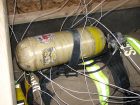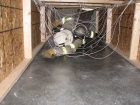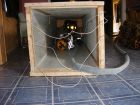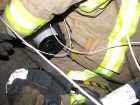
Back to Basics: April 2019
By Mark van der Feyst
Features TrainingWe are continuing our look at the four categories of self-contained breathing apparatus (SCBA) emergencies with our focus on moving onto entanglements.
No matter what type of building we find ourselves in, there is always a chance or opportunity for us to become entangled. Lying within any building, are many items that can entangle us such as:
- Window curtains – Mostly associated with residential buildings, these types of hazards come in many forms such as fabric curtains, window shades, aluminum or wood blinds, honeycomb shades, roller shades, solar shades, bamboo woven wood shades, vertical blinds and shutters. Not only is the material the hazard, but also the hardware used to hang them such as rope type systems and track systems.
- Dryer duct – This can be found in both residential and commercial types of buildings. Depending upon where the dryer duct is running, sometimes above a ceiling or along the floor, these hazards are deadly. Once the plastic or aluminum foil covering has melted away, a very thin wire frame resembling a slinky toy is exposed, allowing anything passing by to be snagged.
- Suspended ceilings – These will be found in residential buildings like in finished basements, as well as in commercial buildings. These ceilings are used to conceal the wiring, HVAC and any other mechanical lines running above. The danger with these types of hazards is the collapse of the above hidden wires, ductwork or cables onto the firefighters below. These ceilings are only suspended using a thin wire.
- Wires/cables/HVAC – As mentioned above, each of these items are found in any building and no matter where they are located, they will easily entangle a firefighter.
When we study LODDs involving entanglements, we can see how one simple piece of material is all it takes to prevent a firefighter from getting out.
An example of this was in Memphis, Tenn., on April 11, 1994, where one of two firefighters died due to being entangled in coaxial cables. As a result of this situation and others like it, firefighter survival techniques were implemented to help firefighters become disentangled. There are four techniques that can be used to help any one firefighter become unentangled when they encounter such hazards.
The first technique is the swim technique. The firefighter uses either a front stroke or a back stroke to try to free himself or herself from the wire collapse on top of them. Mimicking a swim in a pool, the back stroke will require using the one arm to extend out fully in font of and then lift the wires up and over his or her body as they navigate through. By doing this, they will hopefully be able to move themselves out of harm’s way and carry on to an exit point or with their task.
The front stroke is the opposite where the firefighter will be on his or her back and using his or her arm in the opposite fashion to the back stroke.
While they are using the stroke method to free themselves, they need to push themselves with their feet to get them through and away from the hazard. Another tip is to flip yourself onto your back or side, so as to bury the SCBA cylinder and hide it from being an exposure point for entanglement. When there is a snag point created with a wire or some other item, the firefighter needs to not panic, but rather put some tension on the item, so that they can easily locate the item to free themselves from it. When we feel a snagging of sort, we tend to back away allowing slack to be present – this will not allow us to locate the entanglement. Put some tension in it, hold it, locate it and then remove it by using the front or back stroke.
The second technique is to do a partial removal of the SCBA. This is where the firefighter will remove only one half of the SCBA to allow him or her to free the SCBA from the entanglements and navigate though the hazard. The important aspect of this is to only take off the one side that is not the regulator side so as to allow the firefighter to not put any undue tension on the low-pressure regulator hose.
The third technique is an add-on from the second technique – full removal of the SCBA. The firefighter removes the SCBA from off his or her back and pushes it in front as he or she moves through or away from the hazard. As discussed, and detailed in the January 2019 issue of our series, the firefighter is going to make sure that the SCBA is going ahead of them with the cylinder valve leading the way. Once they are free of the hazards, they can don the SCBA back on their back and continue out.
The last technique is using wire cutters and cutting your way out. Every firefighter should carry two pairs of wire cutters on him or her, with only one pair being the minimum. One pair of cutters should be located up top in the coat – perhaps the radio pocket, with the other pair located in the bottom half such as the cargo pocket. The thought here is, if we only have access to the top half of our body, we can grab our cutters.
The wire cutters that you will want to carry and use will be of a large-handle type, with a large opening of the blades, so that the item being cut can fit inside easily and be cut easily with structural fire gloves on. Some wire cutters have a stripping notch located at the crux of the two blades – this is bad as small wires will fit in there and not be cut.
Sometimes, an entanglement can occur where swimming your way out will not work, taking off the SCBA will not work, but cutting it will. This is where wire cutters will help. Before you cut, make sure you know what you are cutting. Use your hand to grab the object, put tension on it, put the wire cutters opened around the object, then cut. If this is being done near your facepiece, make sure you are not cutting the low-pressure regulator hose at the same time. I have seen this done and it does not help with the survival operation nor with the RIT operation either.
Mark van der Feyst has been in the fire service since 1999 and is a full-time firefighter in Ontario. He teaches in Canada, the United States and India and is lead author of Residential Fire Rescue. Mark@FireStarTraining.com
Print this page



